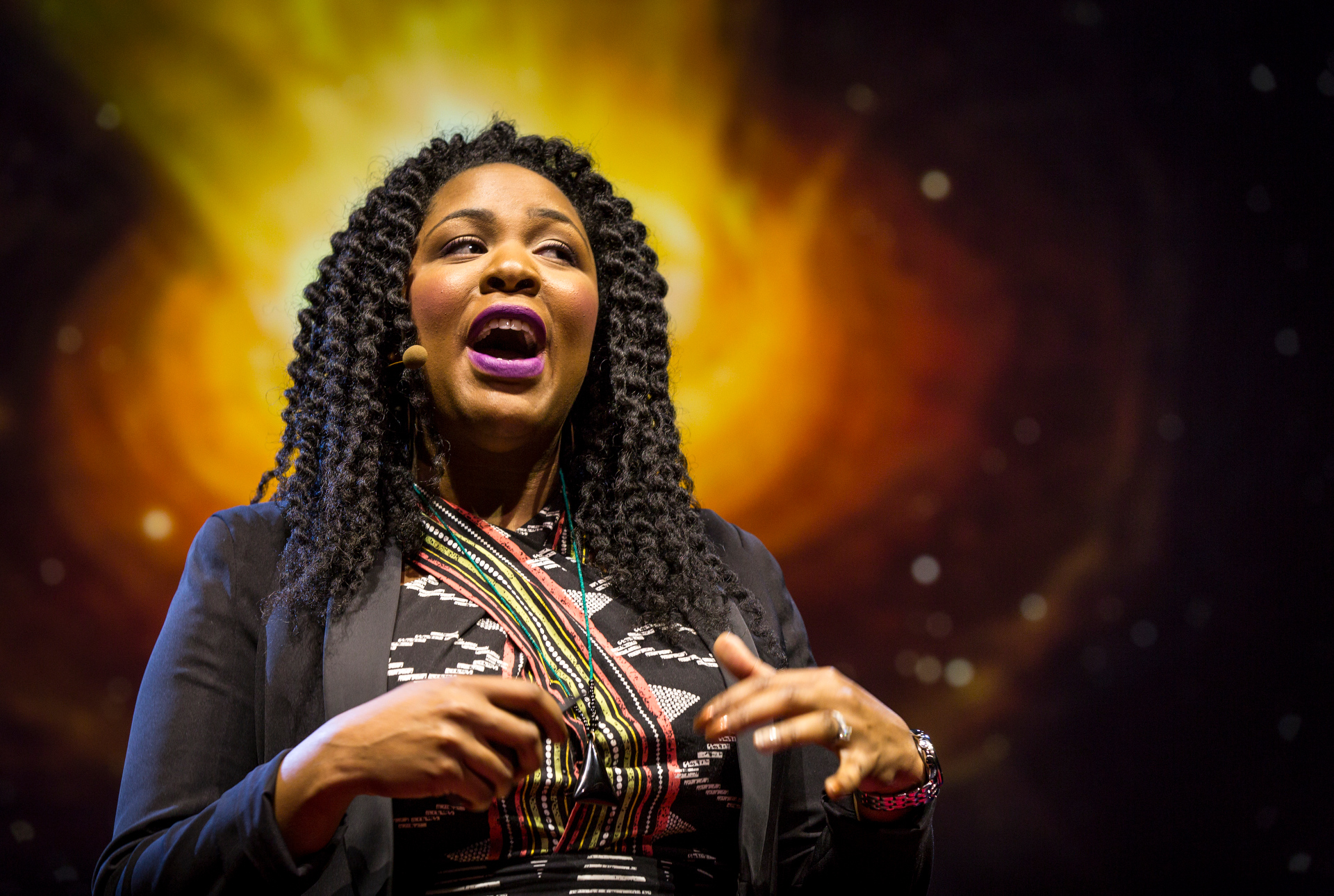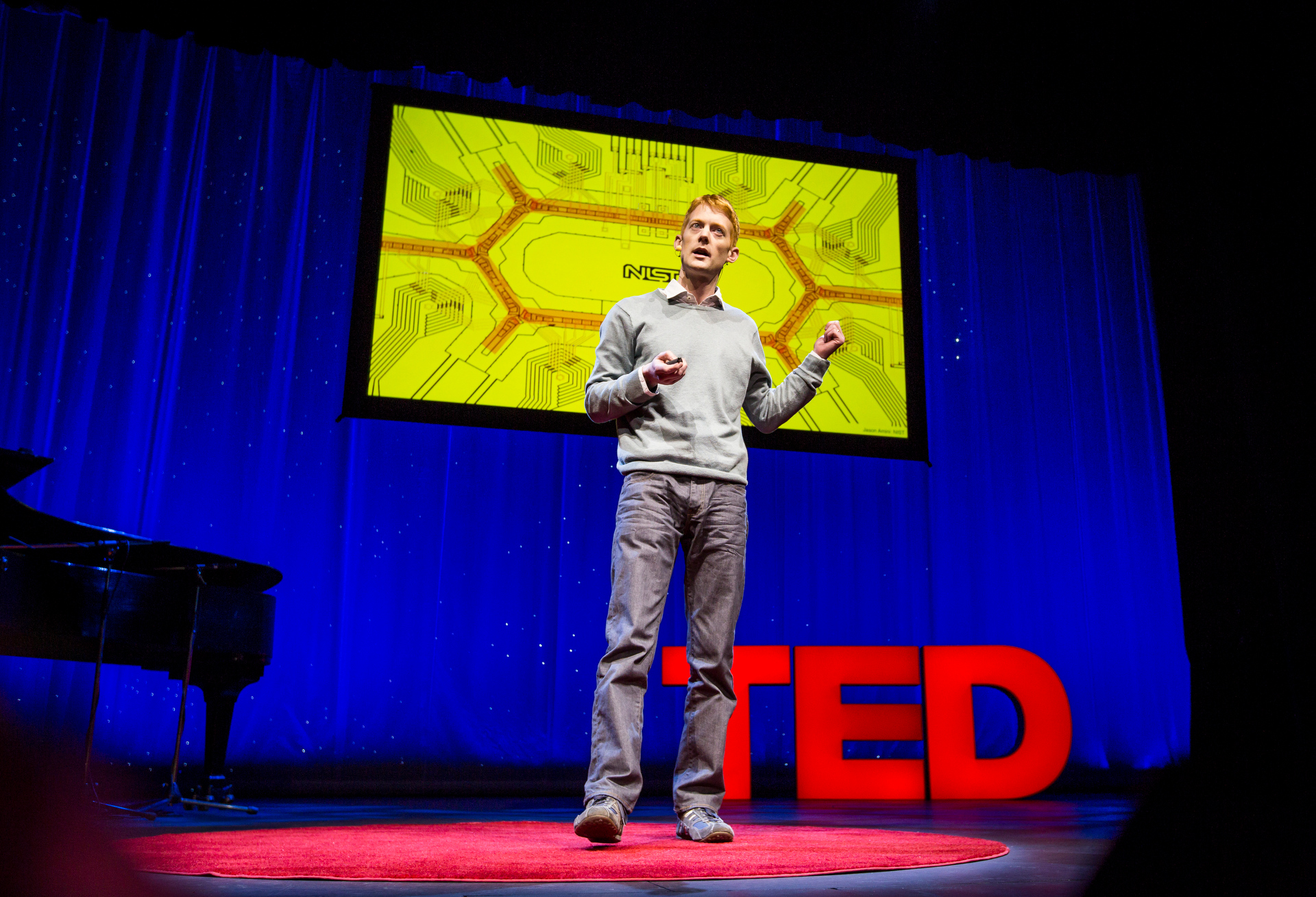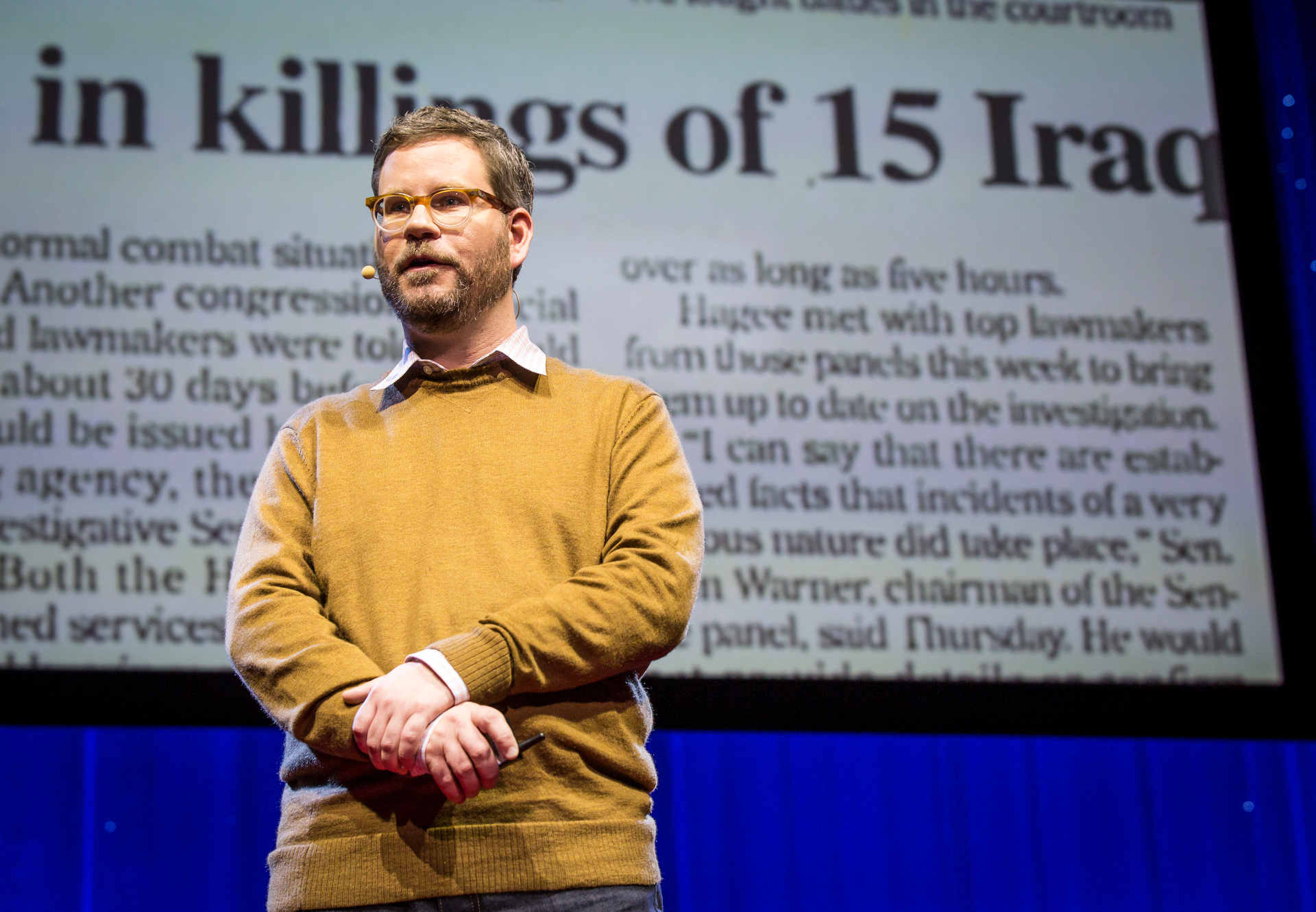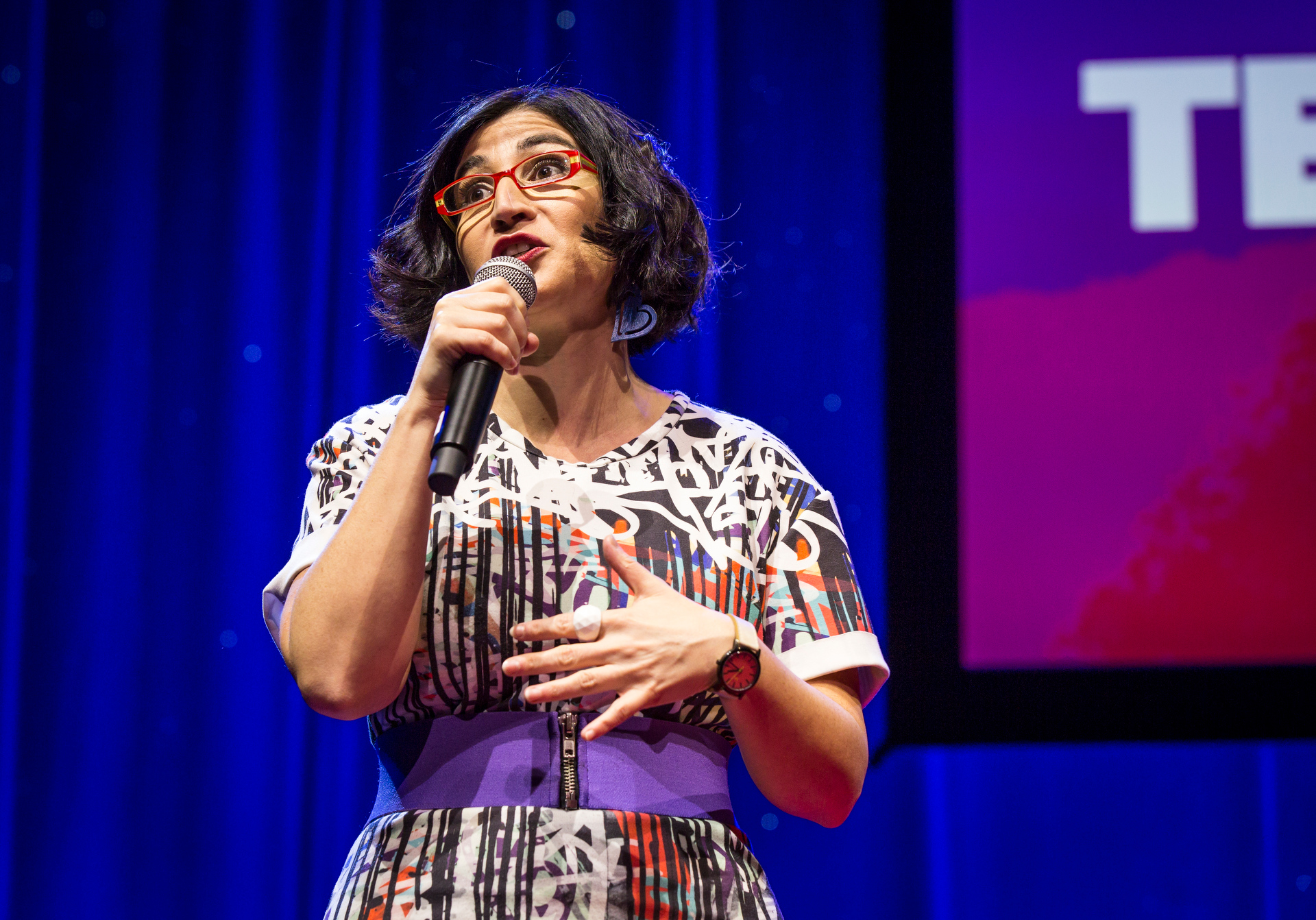
Astrophysicist Jedidah Isler talks about the wonder of supermassive hyperactive black holes — called blazars, or blazing quasars — during TED Fellows Talks, Session 1. Photo: Ryan Lash/TED
TED Fellows and Senior Fellows have just opened TED2015 with a bang in the beautiful Kay Meek theatre in Vancouver. In the first session, discover: how bacteria can be programmed to detect and treat cancer, a yellow legal pad that smuggles transgressive data into the halls of power, what makes non-state armed groups tick, hyperactive supermassive black holes — and much more.
East African singer Somi sets the mood for the TED2015 Fellows talks with Abbey Lincoln’s “Should Have Been,” accompanied on double bass by Jodi Proznick. (Read more about Somi and her album The Lagos Music Salon on the TED Blog.
There are more bacteria in our bodies than stars in our galaxy, says bioengineer Tal Danino, and they are an integral part of our health. But did you know that we can program bacteria as though they were computers? Danino first engineered bacteria to produce fluorescent proteins in a rhythmic fashion, and generated a molecule that allows bacteria to communicate and synchronize. Danino next turned his attention to using programmable bacteria to detect and treat diseases like cancer. He programmed a bacteria to alert to the presence of liver cancer by producing a molecule that changes the color of urine in cancer’s presence. Another bacteria can be programmed to produce molecules that cause tumors to shrink. Danino also produces beautiful works of art using bacteria engineered to form complex patterns; he shows an image of a colorful and intricate mandala, a symbol of the universe, that speaks to the power and beauty of the invisible.
Slovenian photographer Jošt Franko takes us to Gaza, about two months after the 2014 war, to show us the devastating and often unseen consequences of conflict. Many of his subjects, rendered in black and white, are Palestinian farming families deeply affected by the atrocities of war, people whose homes have been destroyed and whose land and crops have been rendered uncultivable or lost to encroaching buffer zones between Israel and the Gaza Strip. His images show children living in a UN refugee school, farmers looking over their ruined fields, a makeshift rooftop playground surrounded by snipers. “I aim my camera at the world beyond the world of fighting and blood, and document lives,” he says. “The main story of every war isn’t the fighting but civilians who struggle to survive long after the bombing has stopped.”
Whiteflies devastate cassava by transmitting a destructive virus to the staple crop, on which 700 million people depend for their daily food. Smallholder farmers in Africa rely on cassava not only to feed their families, but as a cash crop that pays for the other necessities of life, such as school fees and health care. Computational biologist Laura Boykin uses genomics, supercomputing and phylogenetics to study the speciation of whitefly. So far, she has identified 34 species of Bemisia tabaci, information crucial for researchers to develop cassava that is genetically modified to be virus resistant as well as resistant to the correct whitefly. She announces that her team at the University of Western Australia is making this information available to the scientific community with the launch of WhiteFlyBase – the world’s first database of whitefly genetic information. Boykin’s dream: to soon see East African markets filled with healthy and plentiful cassava, and for the region to be food secure for many years to come.

Jonathan Home is building a quantum computer at the atomic level. He explains during TED Fellows Talks, Session 1, at TED2015. Photo: Ryan Lash/TED
Have you ever seen an atom? In the photograph that opens quantum scientist Jonathan Home’s talk, a lineup of seven individual atoms look like a row of stars. These are the building blocks of matter — but Home is isolating them in order to build a new kind of computer, one that can solve complex problems of science and mathematics — as well as crack RSA cryptography — far more quickly than a classic supercomputer, using far less space. So how to build one? Home manipulates individual atoms’ quantum states using laser pulses, and manipulates the connections between atoms to create circuits, using atoms as quantum wires to communicate information. How close are we to quantum computing? There is no fundamental barrier, says Home. The challenge now is to build larger systems, requiring building more complex structures, something that may be possible with fabrication methods used to make the chips in our current-day laptops.
Neuroscientist and co-founder of Backyard Brains Greg Gage delights the crowd with a demo of his Human-to-Human Interface, the latest in his set of low-cost, DIY kits designed to make learning about neuroscience accessible to young people. Applying sensors to the arms of volunteers Samantha and Miguel (“You’re about to lose your will,” Gage warned), Gage showed how electrical activity from Sam’s brain as she flexed her arm sent a signal to Miguel’s ulnar nerve, causing his arm to contract involuntarily. The best part? When Gage manipulated Samantha’s arm himself, nothing happened — proving that brain activity, not muscles, are the origin of movement.
At 12, astrophysicist Jedidah Isler fell for the love of her life: the night sky. Now she studies some of the most exotic objects in the universe, including supermassive hyperactive black holes called blazars — or blazing quasars. These devour material at the rate of a thousand times more than an average supermassive black hole, and produce powerful particle streams. Blazars pull in material via an accretion disk that spins around the black hole, and shoot it out via jets that move at 99.99% the speed of light — some of which are pointed at Earth. Isler is working to understand how and where the highest-energy light from the jet is made, and how energy is transported through the galaxy. “Who knew that chasing after the universe would ground me so deeply to my mission here on Earth? Then again, when do we ever know where love’s first flutter will truly take us?”
As a result of the US-led invasion of Iraq, an estimated 150,000 to 1 million Iraqis lost their lives, says artist Matt Kenyon — a number that stands in startling contrast to the 4,486 American service members who died in the same period. Yet it’s the latter number most often quoted in Western media. Wanting to create a monument to individual Iraqi lives, Kenyon took inspiration from a school civics assignment, in which a teacher encouraged students to write a thoughtful letter to a member of government in the hope of getting a reply. His monument, Notepad, looks like an everyday yellow legal pad, but its lines, specially printed in microtext, contain the names, locations and dates of Iraqi civilian casualties. Kenyon has smuggled these pads into the stationery supplies of US and coalition governments, sort of a Trojan horse of transgressive data. Now he offers each member of the Fellows audience a sheet, asking them to use it to write to a member of US government. As each piece of government correspondence is archived in the Library of Congress, Kenyon’s monument will infiltrate and become part of the US permanent historical record.

Artist Matt Kenyon wants to infiltrate the halls of power with transgressive data. Photo: Ryan Lash/TED
Physical therapy can be painful, frustrating and boring, as Romanian physical therapy entrepreneur Cosmin Mihaiu knows firsthand. As a kid, he fell out of a tree and broke his arm during a game of hide-and-seek. His physical therapist advised him to flex and extend his arm 100 times a day, 7 days a week, to regain movement after the cast came off. Of course he balked at doing his exercises, and recovery took months longer than necessary. His story is common: patient noncompliance in physical therapy is high. Mihaiu’s software platform MIRA Rehab could change all that. Running on a PC with a Kinect controller, MIRA creates fun-to-play games that lead patients through therapy-specific exercises — like navigating a bumblebee through a garden with flex-and-extend motions — while allowing physical therapists to monitor recovery. The games are appropriate for all ages and address orthopedic and neurological problems, and more games are in development for children with autism and for speech therapy. MIRA Rehab is already being used in 10 clinics in Europe and the United States. Meanwhile, a home version is in the works.
“What do non-state armed groups do when they’re not shooting?” asks Middle East policy analyst Benedetta Berti. In order to engage or defeat groups like Hamas, Hezbollah or ISIL, we need to understand what makes them tick. Contrary to their portrayal in Western media, non-state groups are quite plugged in. Hamas has set up media communication — radio, TV, its own social media strategy, says Berti. ISIL even has its own glossy magazine, published in English for the sake of recruitment. Non-state groups launch for-profit companies that fund their activities. But what makes them so popular? Berti suggests that non-state groups are filling a vacuum by offering the services governments are failing to provide. They win populations over by building schools and hospitals, and offering vocational training programs and microloans. And, as with the Taliban, they can offer personal safety, social order and security. Yet in the West, all we see is the violence. Once we accept how complex and sophisticated such groups are, the less we can think of them as the opposite of the state. “Military can win battles but not give us peace,” says Benedetti. Perhaps the journey there will require governments to invest more in their people’s nonmilitary needs. Read more on ideas.ted.com.
Astronomer Aomawa Shields looks for other planets in the universe where life might exist. While some astronomers do this work by measuring the distance between planets and their suns, Shields uses computer models to calculate the kind of atmosphere a planet would need in order to be able to support life, because while distance to a star is one marker of habitability, it’s not the only one. For example, while Venus looks hospitable, its surface is 900 degrees Fahrenheit, hot enough to melt lead – not due to its proximity to the sun but to its thick atmosphere, which traps heat. Another contradiction: ice on a planet orbiting a cooler star could absorb heat to make it warmer than a planet orbiting a warmer star. Shields, who besides being an astronomer is a classically trained actor, also works to interweave science, art and education with her organization Rising Stargirls, which teaches astronomy to middle-school girls of color, using theater, writing and visual art. She hopes that “maybe one day they’ll join the ranks of astronomers who are full of contradictions — and use their backgrounds to discover, once and for all, that we are truly not alone in the universe.”

Negin Farsad skewers the Iranian-American experience during TED Fellows talks. Photo: Ryan Lash/TED
What do mushrooms have to do with climate change? In agricultural entrepreneur Trang Tran’s native Vietnam, farmers traditionally burn the straw left over after the rice harvest, twice a year, for two months at a time. This is a common practice in rice-producing countries around the world, says Tran. In Vietnam alone, 20 million tons of rice straw are burned annually, releasing greenhouse gases into the atmosphere, and the particulate matter, when inhaled, causes health problems in poor communities. Tran and a friend did some research and discovered rice straw is a perfect substrate for growing mushrooms. They gathered some straw, soon had a delicious crop of mushrooms, and even found that the used substrate made excellent amendment for soil. When Tran returned to Vietnam from getting her MBA in the US, she launched her social enterprise Fargreen to teach farmers this sustainable, profitable and closed-loop mushroom production model — which also saves farmers from having to travel to the city between rice crops to earn money. Fargreen’s farmers have so far collectively saved 10 tons of straw from being burned — equivalent to 10 tons of greenhouse gases.
Paleontologist and National Geographic explorer Nizar Ibrahim wonders why so many of our favorite exotic, alien worlds and creatures exist as figments of our imagination? He takes us on a tour of what is now the Sahara Desert, traveling back in time 100 million years to a lush and extreme ecosystem that he describes as the most dangerous place in the history of our planet. “Three different kinds of flying dragons inhabit this alien world,” he says, “and its huge river systems cover an area approaching the size of the continental US — in which giant river monsters patrol in search of car-sized fish.” This aquatic dinosaur, Spinosaurus, was bigger than T rex, had a sail taller than a human, long slender jaws for fishing — and, says Ibrahim, makes our imaginary dragons seem pretty boring in comparison. Ibrahim, who helped co-discover the Spinosaurus, continues to comb the Sahara sands for fossils of these fantastic creatures, his discoveries resurrecting a real past that is more bizarre than we could possibly imagine.
Standup comedian, filmmaker and writer Negin Farsad ends Session 1 with an edgy, uproarious and downright scatological take on the trials and tribulations of being an Iranian-American in Iran (“Maybe I should hide all the freedoms I enjoy — like boys, and alcohol, and peaceable assembly…”), involving an unfortunate incident with an American-style, husband-repelling toilet.
Comments (2)